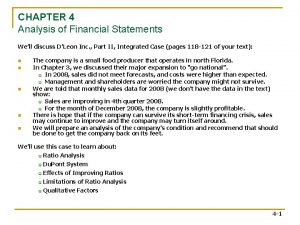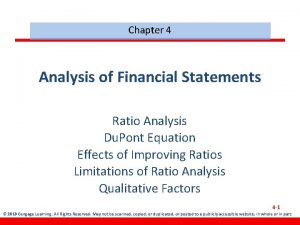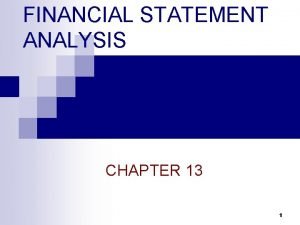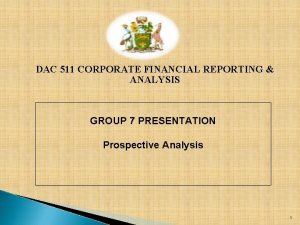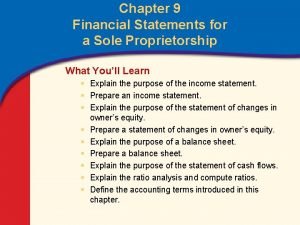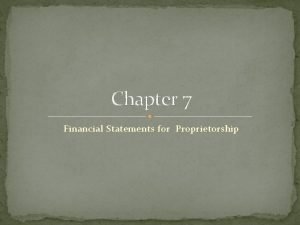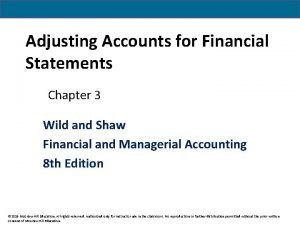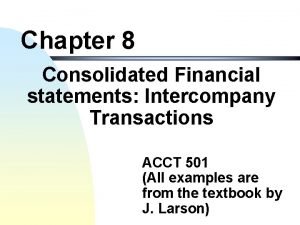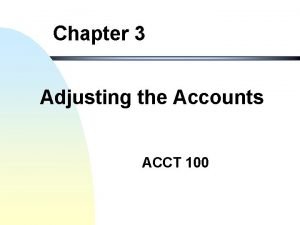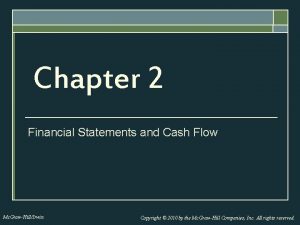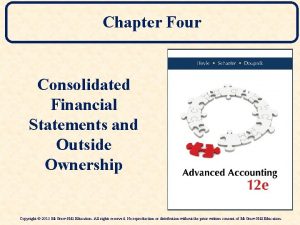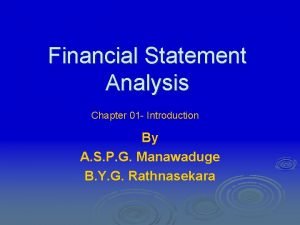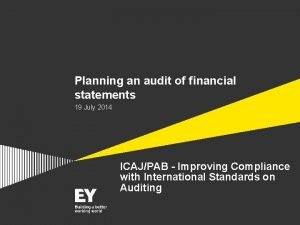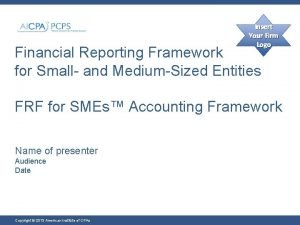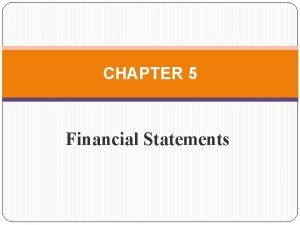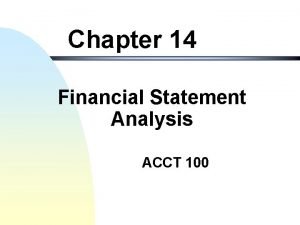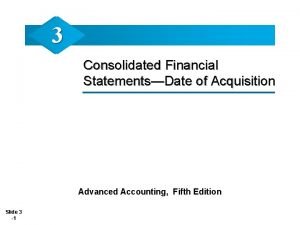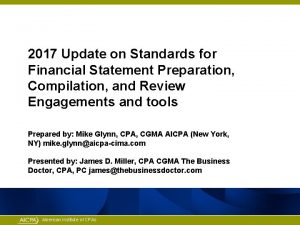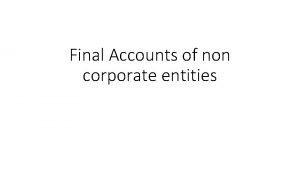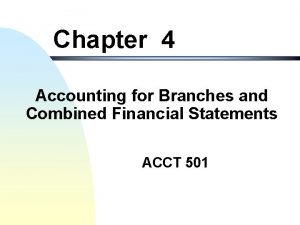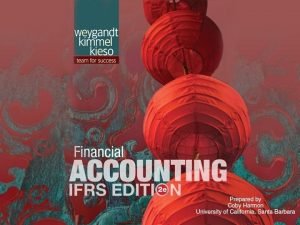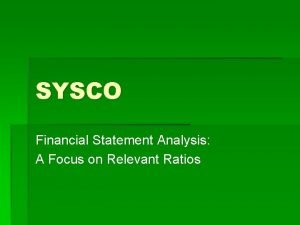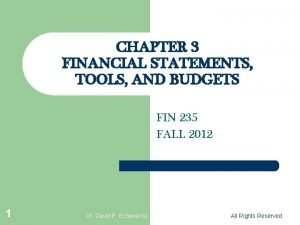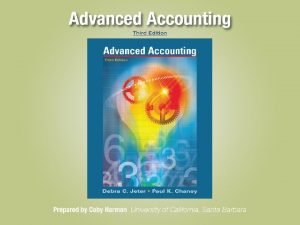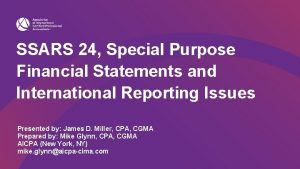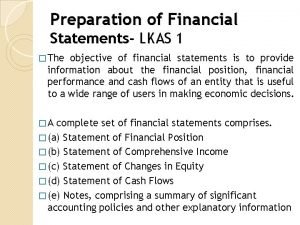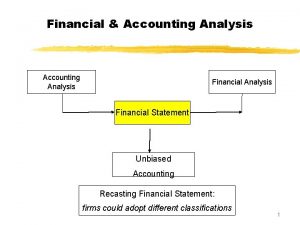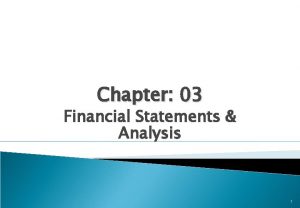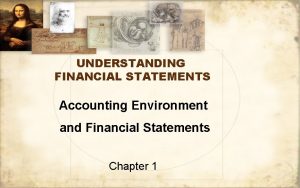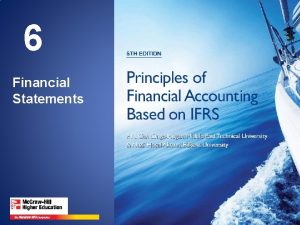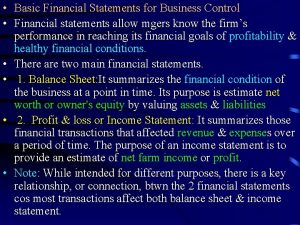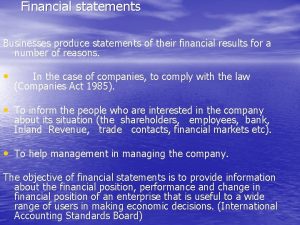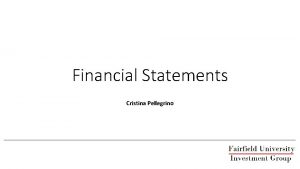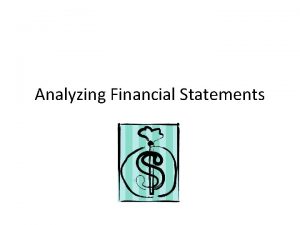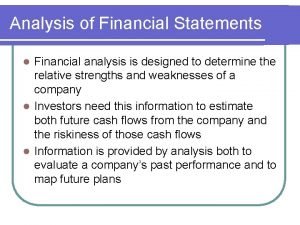Chapter 8 Financial Statements and Analysis Introduction to














































- Slides: 46

Chapter 8 Financial Statements and Analysis Introduction to Finance Lawrence J. Gitman Jeff Madura

Learning Goals Review the contents of the stockholder’s report, and the procedures for consolidating financial statements. Understand who uses financial ratios and how. Use ratios to analyze a firm’s liquidity and activity. Discuss the relationship between debt and financial leverage and the ratios used to analyze a firm’s debt. Use ratios to analyze a firm’s profitability and its market value. Use the Du. Pont system of analysis to perform a complete ratio analysis. Copyright © 2001 Addison-Wesley 8 -1

The Stockholders’ Report n The guidelines used to prepare and maintain financial records and reports are known as generally accepted accounting principles (GAAP). n GAAP is authorized by the Financial Accounting Standards Board (FASB). n Public corporations with more than $5 million in assets and more than 500 stockholders are required by the SEC to provide their stockholders with an annual stockholders’ report. Copyright © 2001 Addison-Wesley 8 -2

Financial Statements n The Income Statement w The income statement provides a financial summary of a company’s operating results during a specified period. w Although they are prepared annually for reporting purposes, they are generally computed monthly by management and quarterly for tax purposes. Copyright © 2001 Addison-Wesley 8 -3

Financial Statements Copyright © 2001 Addison-Wesley Table 8. 1 (Panel 1) 8 -4

Financial Statements Copyright © 2001 Addison-Wesley Table 8. 1 (Panel 2) 8 -5

Financial Statements n The Balance Sheet w The balance sheet presents a summary of a firm’s financial position at a given point in time. w Assets indicate what the firm owns, equity represents the owners’ investment, and liabilities indicate what the firm has borrowed. Copyright © 2001 Addison-Wesley 8 -6

Financial Statements Copyright © 2001 Addison-Wesley Table 8. 2 (Panel 1) 8 -7

Financial Statements Copyright © 2001 Addison-Wesley Table 8. 2 (Panel 2) 8 -8

Financial Statements n Statement of Retained Earnings w The statement of retained earnings reconciles the net income earned and dividends paid during the year with the change in retained earnings. Copyright © 2001 Addison-Wesley 8 -9

Financial Statements Copyright © 2001 Addison-Wesley Table 8. 3 8 -10

Financial Statements n Statement of Cash Flows w The statement of cash flows provides a summary of the cash flows over the period of concern, typically the year just ended. w This statement not only provides insight into a company’s investment and financing and operating activities, but also ties together the income statement and previous and current balance sheets. Copyright © 2001 Addison-Wesley 8 -11

Financial Statements Copyright © 2001 Addison-Wesley Table 8. 4 8 -12

Consolidating International Financial Statements n FASB 52 mandated that companies based in the United States translate their foreign-currency denominated assets and liabilities into dollars using the current rate (translation) method. n Under the translation method, companies translate foreign-currency-denominated assets and liabilities into dollars for consolidation with the parent company’s financial statements. n Income statement items are usually treated similarly, although they can also be translated at the average exchange rate during the period (year). Copyright © 2001 Addison-Wesley 8 -13

Consolidating International Financial Statements n Equity accounts, on the other hand, are translated into dollars by using the exchange rate that prevailed when the parent’s equity investment was made (the historical rate). n Retained earnings are adjusted to reflect each year’s operating profits (or losses), but do not consider any profits or losses resulting from currency changes. n Instead, translation gains and losses are accumulated in an equity reserve account called the cumulative translation adjustment. Copyright © 2001 Addison-Wesley 8 -14

Consolidating International Financial Statements n Translation gains (losses) increase (decrease) this account balance. n However, the gains and losses are not “realized” until the parent company sells or shuts down the subsidiary. Copyright © 2001 Addison-Wesley 8 -15

Using Financial Ratios n Interested Parties w Ratio analysis involves methods of calculating and interpreting financial ratios to assess a firm’s financial condition and performance. w It is of interest to shareholders, creditors, and the firm’s own management. Copyright © 2001 Addison-Wesley 8 -16

Types of Ratio Comparisons n Trend or Time-Series Analysis w Used to evaluate a firm’s performance over time. n Cross-Sectional Analysis w Used to compare different firms at the same point in time. w Industry comparative analysis • One specific type of cross sectional analysis. Used to compare one firm’s financial performance to the industry’s average performance. n Combined Analysis w Combined analysis simply uses a combination of both time-series analysis and cross-sectional analysis. Copyright © 2001 Addison-Wesley 8 -17

Types of Ratio Comparisons Copyright © 2001 Addison-Wesley Figure 8. 1 8 -18

Cautions for Doing Ratio Analysis n Ratios must be considered together; a single ratio by itself means relatively little. n Financial statements that are being compared should be dated at the same point in time. n Use audited financial statements when possible. n The financial data being compared should have been developed in the same way. n Be wary of inflation distortions. Copyright © 2001 Addison-Wesley 8 -19

Ratio Analysis Example n Using Daton Company Financial Statements w Liquidity ratios w Activity ratios w Financial leverage ratio w Leverage ratios w Profitability ratios Copyright © 2001 Addison-Wesley 8 -20

Ratio Analysis n Liquidity Ratios w Current Ratio Current ratio = Copyright © 2001 Addison-Wesley Total current assets Total current liabilities $1, 233, 000 $620, 000 = 1. 97 8 -21

Ratio Analysis n Liquidity Ratios w Quick ratio Total current assets - Inventory Quick ratio = Total current liabilities $1, 233, 000 - $289, 000 Quick ratio = $620, 000 Copyright © 2001 Addison-Wesley = 1. 51 8 -22

Ratio Analysis n Activity Ratios w Inventory Turnover Inventory turnover = Copyright © 2001 Addison-Wesley Cost of goods sold Inventory $2, 088, 000 $289, 000 = 7. 2 8 -23

Ratio Analysis n Activity Ratios w Average collection period ACP = Accounts receivable Net sales/360 $503, 000 ACP = = 58. 9 days $3, 074, 000/360 Copyright © 2001 Addison-Wesley 8 -24

Ratio Analysis n Activity Ratios w Average payment period APP = Accounts payable Annual purchases/360 $382, 000 ACP = = 94. 1 days (. 70 x $2, 088, 000)/360 Copyright © 2001 Addison-Wesley 8 -25

Ratio Analysis n Activity Ratios w Total asset turnover = Copyright © 2001 Addison-Wesley Net sales Total assets $3, 074, 000 $3, 579, 000 =. 85 8 -26

Ratio Analysis n Financial Leverage Ratio w Debt ratio Total liabilities Debt ratio = Total assets Debt ratio = Copyright © 2001 Addison-Wesley $1, 643, 000 $3, 579, 000 = 45. 7% 8 -27

Ratio Analysis n Leverage Ratios w Times interest earned ratio Times interest earned = Copyright © 2001 Addison-Wesley EBIT Interest $418, 000 $93, 000 = 4. 5 8 -28

Ratio Analysis n Leverage Ratios w Fixed-payment coverage ratio (FPCR) FPCR = EBIT + Lease pymts Interest + Lease pymts + {(Princ pymts + PSD) x [1/(1 - t)]} $418, 000 + $35, 000 $93, 000 + $35, 000 + {($71, 000 + $10, 000) x [1/(1 -. 29)]} Copyright © 2001 Addison-Wesley = 1. 9 8 -29

Ratio Analysis n Profitability Ratios w Common-size income statements Copyright © 2001 Addison-Wesley Table 8. 6 8 -30

Ratio Analysis n Profitability Ratios w Gross profit margin GPM = Copyright © 2001 Addison-Wesley Gross profit Net sales $986, 000 $3, 074, 000 = 32. 1% 8 -31

Ratio Analysis n Profitability Ratios w Operating profit margin OPM = Copyright © 2001 Addison-Wesley EBIT Net sales $418, 000 $3, 074, 000 = 13. 6% 8 -32

Ratio Analysis n Profitability Ratios w Net profit margin Net profits after taxes NPM = Net sales NPM = Copyright © 2001 Addison-Wesley $231, 000 $3, 074, 000 = 7. 5% 8 -33

Ratio Analysis n Profitability Ratios w Return on total assets (ROA) Net profits after taxes ROA = Total assets ROA = Copyright © 2001 Addison-Wesley $231, 000 $3, 597, 000 = 6. 4% 8 -34

Ratio Analysis n Profitability Ratios w Return on equity (ROE) Net profits after taxes ROE = Stockholders’ equity ROE = Copyright © 2001 Addison-Wesley $231, 000 $1, 954, 000 = 11. 8% 8 -35

Ratio Analysis n Profitability Ratios w Earnings per share (EPS) Earnings available to common stockholder EPS = Number of shares outstanding EPS = Copyright © 2001 Addison-Wesley $221, 000 76, 262 = $2. 90 8 -36

Ratio Analysis n Profitability Ratios w Price earnings (P/E) ratio P/E = Market price per share of common stock Earnings per share P/E = Copyright © 2001 Addison-Wesley $32. 25 $2. 90 = 11. 1 8 -37

Ratio Analysis n Profitability Ratios w Market/book (M/B) ratio M/B = Market price per share of common stock Book value per share of common stock M/B = Copyright © 2001 Addison-Wesley $32. 25 $23. 00 = 1. 40 8 -38

Summarizing All Ratios Copyright © 2001 Addison-Wesley Table 8. 7 (Panel 1) 8 -39

Summarizing All Ratios Copyright © 2001 Addison-Wesley Table 8. 7 (Panel 2) 8 -40

Du. Pont System of Analysis n The Du. Pont system is used to dissect the firm’s financial statements and to assess its financial condition. n It merges the income statement and balance sheet into two summary measures of profitability: ROA and ROE as shown in Figure 8. 2 on the following slide. n The top portion focuses on the income statement, and the bottom focuses on the balance sheet. n The advantage of the Du. Pont system is that it allows you to break ROE into a profit-on-sales component, an efficiency-of-asset-use component, and a use-ofleverage component. Copyright © 2001 Addison-Wesley 8 -41

Du. Pont System of Analysis Copyright © 2001 Addison-Wesley Figure 8. 2 8 -42

Du. Pont System of Analysis Copyright © 2001 Addison-Wesley Figure 8. 2 (Panel 1) 8 -43

Du. Pont System of Analysis Copyright © 2001 Addison-Wesley Figure 8. 2 (Panel 2) 8 -44

Chapter 8 Introduction to Finance End of Chapter Lawrence J. Gitman Jeff Madura
 Financial statements and ratio analysis chapter 3
Financial statements and ratio analysis chapter 3 Financial statements and ratio analysis chapter 3
Financial statements and ratio analysis chapter 3 Chapter 4 analysis of financial statements
Chapter 4 analysis of financial statements Chapter 4 analysis of financial statements
Chapter 4 analysis of financial statements Financial analysis for banks
Financial analysis for banks Chapter 2 financial statements taxes and cash flow
Chapter 2 financial statements taxes and cash flow Analysis of financial statements
Analysis of financial statements Prospective analysis financial statements
Prospective analysis financial statements Fees earned debit or credit
Fees earned debit or credit Sole proprietorship income statement
Sole proprietorship income statement Sole proprietorship financial statements
Sole proprietorship financial statements Adjusting accounts for financial statements chapter 3
Adjusting accounts for financial statements chapter 3 Chapter 8 separate financial statements
Chapter 8 separate financial statements Working with financial statements chapter 3
Working with financial statements chapter 3 Chapter 3 adjusting accounts for financial statements
Chapter 3 adjusting accounts for financial statements Adjusting entry accrued expense
Adjusting entry accrued expense Cash flow to creditors is equal to
Cash flow to creditors is equal to Unit 13 accounting and financial statements
Unit 13 accounting and financial statements Partial equity method consolidation worksheet
Partial equity method consolidation worksheet Introduction of financial statement analysis
Introduction of financial statement analysis Statement of financial purpose
Statement of financial purpose Planning an audit of financial statements
Planning an audit of financial statements Sample notes to financial statements for small entities
Sample notes to financial statements for small entities Financial statements translation
Financial statements translation Fge financial management
Fge financial management Acct 100
Acct 100 Parsimonious method of forecasting
Parsimonious method of forecasting Consolidated financial statements date of acquisition
Consolidated financial statements date of acquisition Ssars 21 engagement letter example
Ssars 21 engagement letter example What is cost benefit constraint
What is cost benefit constraint Ias consolidated financial statements
Ias consolidated financial statements Standardized financial statements
Standardized financial statements Financial statements of non corporate entities
Financial statements of non corporate entities Branch balance sheet
Branch balance sheet Statement of financial position for merchandising
Statement of financial position for merchandising Four financial statements
Four financial statements Ifrs 17 effective date
Ifrs 17 effective date Sysco financial statements
Sysco financial statements Four primary financial statements
Four primary financial statements Financial statements tools
Financial statements tools Translation of financial statements
Translation of financial statements Sole trader financial statements example
Sole trader financial statements example A company has sales of 695 000 and cost of goods
A company has sales of 695 000 and cost of goods Special purpose financial statements
Special purpose financial statements Lkas 01
Lkas 01 Prospective accounting
Prospective accounting Translation of financial statements
Translation of financial statements


